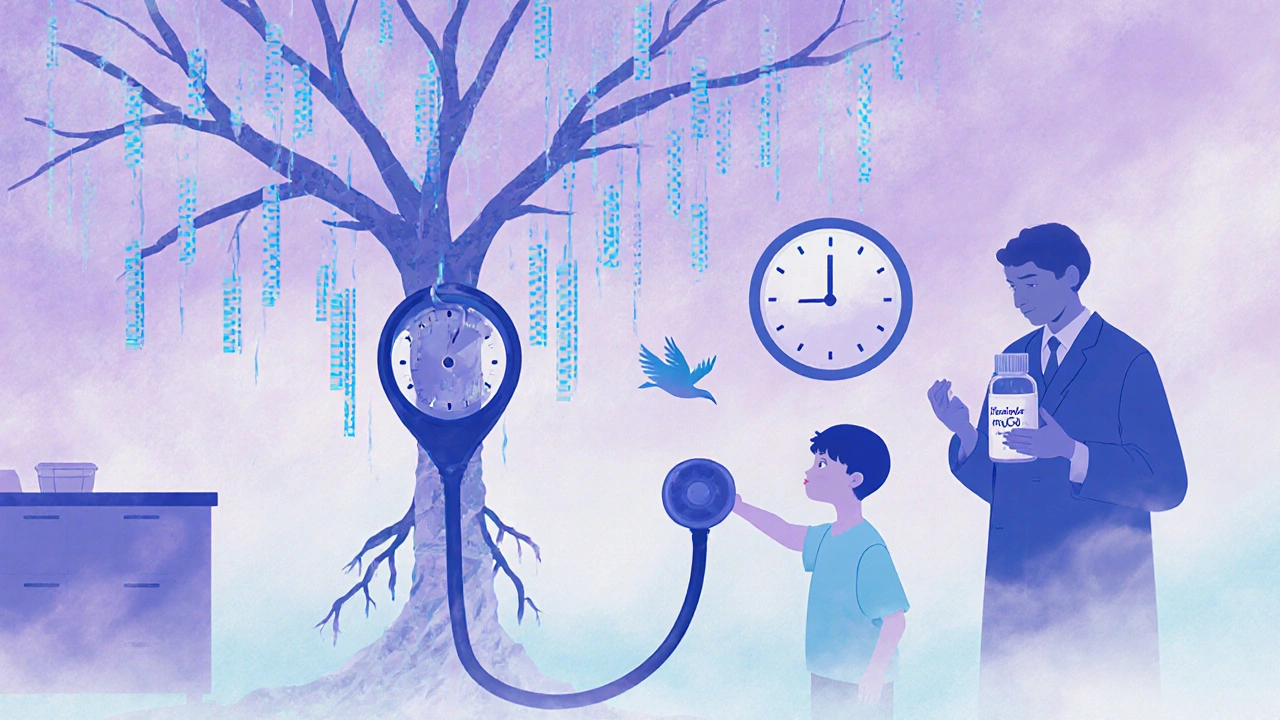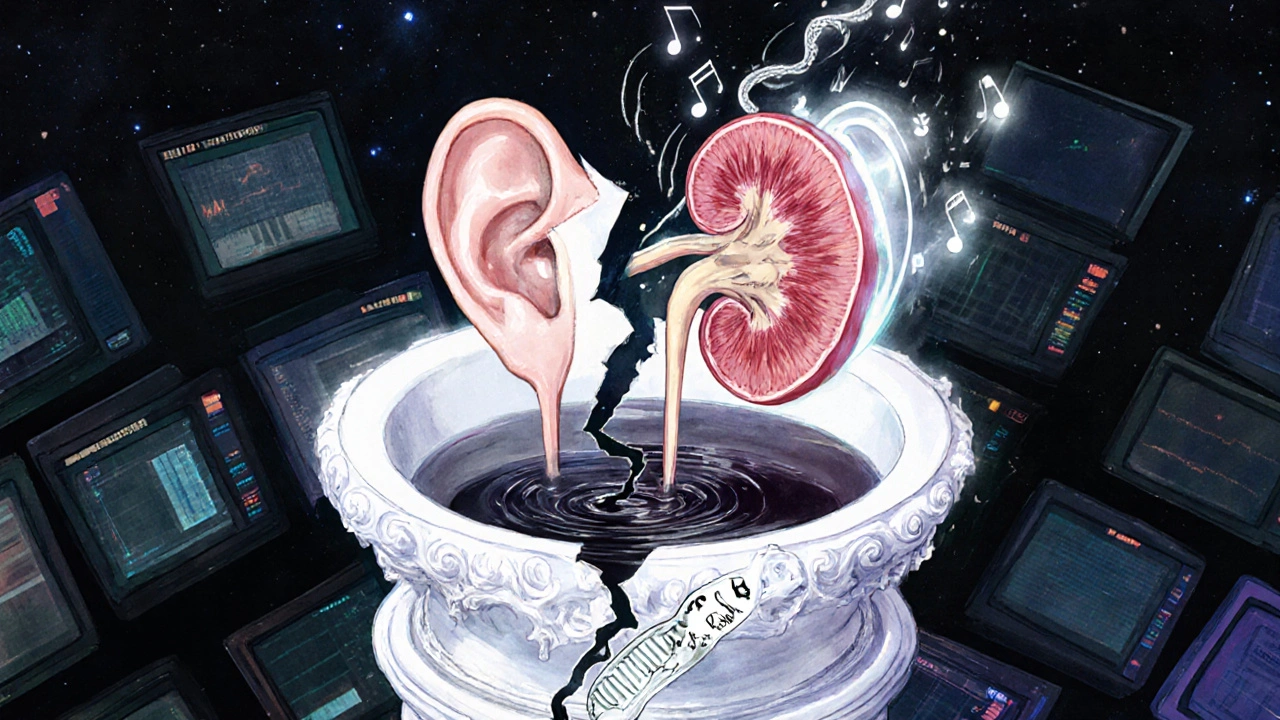Vancomycin Risk Calculator
Vancomycin saves lives. It’s one of the few antibiotics that can stop MRSA dead in its tracks when nothing else works. But for every patient it helps, there’s a real chance it could harm them-either by damaging their kidneys or their hearing. And here’s the problem: vancomycin nephrotoxicity is common. Vancomycin ototoxicity is rare. But when ototoxicity hits, it’s often permanent. So how do doctors decide when to use it-and how to keep patients safe?
Why Vancomycin Is Still Used Despite the Risks
Vancomycin isn’t new. It’s been around since the 1950s. Back then, it was messy-impure, unpredictable, and hard on the kidneys. Over half of patients developed kidney damage. Today’s version is cleaner, purified, and better controlled. But even modern vancomycin carries risks. The reason it’s still first-line for serious Gram-positive infections? Because alternatives like daptomycin or ceftaroline aren’t always effective, aren’t always available, or come with their own dangerous side effects. For many patients, vancomycin is the only option that works. That means clinicians can’t just avoid it. They have to manage it carefully.Nephrotoxicity: The More Common, But Often Reversible Threat
Nephrotoxicity-the damage to the kidneys-is the most frequent problem. Studies show it happens in 5% to 30% of patients, depending on how you define it and who’s taking the drug. In intensive care units, where patients are sicker and often on multiple drugs, the rate jumps to 30-50%. Why? Because vancomycin doesn’t just float through the body. It builds up in the proximal tubules of the kidneys, where it triggers oxidative stress and disrupts energy production in cells. That’s what leads to acute kidney injury (AKI). The biggest risk factors? High trough levels (above 15-20 mcg/mL), treatment lasting longer than 7 days, and especially, combination therapy. If you give vancomycin with piperacillin-tazobactam, the risk of AKI nearly doubles. A 2022 meta-analysis of over 14,500 patients found that combination therapy increased AKI risk by 31% compared to vancomycin with meropenem. That’s not a small difference. It’s a red flag. But here’s the good news: most vancomycin-related kidney damage is reversible. If caught early-by checking creatinine every 48 to 72 hours-it often resolves within days after stopping the drug. No dialysis needed. No long-term scarring. Just a pause, a recheck, and a switch to a safer antibiotic if possible.Ototoxicity: The Silent, Irreversible Danger
Ototoxicity is the opposite. It’s rare-only 1% to 3% of patients. But when it happens, it doesn’t go away. It’s sensorineural hearing loss, usually starting in the high frequencies. Tinnitus often comes first. Then, patients realize they can’t hear birds chirping, children’s voices, or even the alarm clock. And it’s bilateral-both ears. The scary part? You can’t predict it well. Some patients develop it with trough levels under 15 mcg/mL. Others get it after just three doses. A 2023 case report in Cureus described a patient with perfectly normal kidney function who lost hearing after only three infusions. No warning. No warning signs in blood tests. Just sudden, permanent damage. Unlike nephrotoxicity, there’s no reliable lab test for ototoxicity. Creatinine doesn’t tell you anything. No biomarker exists. The only way to catch it early is with audiometry-pure tone testing that measures hearing thresholds. But only 37% of U.S. hospitals have formal protocols for this. Most rely on patients reporting symptoms. By then, it’s often too late. And here’s the cruel twist: the highest risk isn’t always tied to the highest trough. One study found that patients with ototoxicity had mean troughs of 19 mcg/mL-right in the “target” range. The damage seems to depend on individual susceptibility. Genetics play a role. A 2022 study in Nature Communications found that people with a specific variant in the MT-RNR1 gene had over three times the risk of hearing loss.Monitoring: What Works, What Doesn’t
For nephrotoxicity, monitoring is standard. Most hospitals check creatinine every 2-3 days. Some use AUC (area under the curve) monitoring instead of just trough levels. AUC gives a better picture of total drug exposure over time. A 2023 trial showed that switching to AUC-guided dosing cut nephrotoxicity in half-from 18.7% down to 9.4%. That’s a game-changer. But for ototoxicity? It’s a mess. The American Speech-Language-Hearing Association recommends baseline and weekly audiograms for patients on high doses or long courses. But in practice? Compliance is low. A survey of hospital pharmacists found only 42% of staff even followed their own audiogram protocols. Why? Cost, time, lack of access to audiologists. One hospital tried it and gave up after three months. Another started offering it only to patients over 65 or with pre-existing hearing loss. That’s pragmatic-but it leaves younger patients at risk.
What Dose Should You Use?
For years, doctors chased troughs of 15-20 mcg/mL, thinking higher meant better killing power. That was a mistake. A 2020 ASHP guideline changed everything. It said: target 10-15 mcg/mL for most infections. Why? Because efficacy plateaus around 10 mcg/mL. But nephrotoxicity risk shoots up above 15 mcg/mL. That’s not a gray area-it’s a cliff edge. Dosing at 4 grams per day? That’s a red flag. A 2008 study showed that dose alone increased nephrotoxicity risk by nearly threefold. And yet, some hospitals still use weight-based dosing that pushes patients over 4 grams. It’s outdated. It’s dangerous. It’s still happening.Combination Therapy: The Hidden Killer
Vancomycin doesn’t usually travel alone. It’s often paired with beta-lactams like piperacillin-tazobactam to cover broader infections. That makes sense clinically. But the data is clear: this combo is a perfect storm. The two drugs together are worse for the kidneys than either one alone. The 2022 meta-analysis showed a 2.31-fold increase in AKI risk. Hospitals that implemented electronic alerts for this combo saw usage drop by 22%. That’s a win. But many still don’t have them. The fix? Avoid the combo unless absolutely necessary. If you’re treating a severe abdominal infection or pneumonia, consider meropenem instead. It’s broader, safer, and doesn’t pile on kidney stress. If you must use vancomycin and piperacillin-tazobactam, monitor creatinine daily. And be ready to switch fast.Who’s at Highest Risk?
Not everyone is equally vulnerable. The 2023 Society of Critical Care Medicine guidelines created a risk score. High-risk patients have at least four of these:- Age over 65
- Pre-existing kidney disease (eGFR under 60)
- ICU admission
- Use of other nephrotoxins (aminoglycosides, NSAIDs, contrast dye)
- Obesity or high body weight
- Vancomycin dose over 4 grams/day
- Treatment longer than 7 days
- Concurrent piperacillin-tazobactam

The Future: Personalized Dosing and Genetic Testing
The future of vancomycin isn’t just about better monitoring-it’s about precision. Tools like DoseMeRx and PrecisePK use algorithms to predict how a patient will process the drug based on weight, kidney function, age, and even genetics. The FDA-cleared DoseMeRx platform predicts nephrotoxicity risk with 86% accuracy. That’s not perfect-but it’s better than guessing. And genetics? That’s the next frontier. If you know a patient has the MT-RNR1 variant, you might avoid vancomycin altogether. Or you might give them a lower dose and schedule an audiogram before day 3. Right now, genetic testing isn’t routine. But in five years? It could be standard for high-risk patients.What Should You Do?
If you’re prescribing vancomycin:- Start low: aim for troughs of 10-15 mcg/mL, not 15-20.
- Check creatinine every 48 hours. Daily if high-risk.
- Avoid vancomycin + piperacillin-tazobactam unless you have no choice.
- If treatment lasts more than 7 days, consider a baseline audiogram-especially if the patient is over 65, has hearing loss, or is on other ototoxins.
- Use AUC monitoring if your hospital has it. It’s worth the cost.
- Know your patient’s risk factors. Don’t treat everyone the same.
- Ask: ‘Is vancomycin the only option?’
- Ask: ‘What are you monitoring?’
- Report any ringing in your ears or trouble hearing high-pitched sounds-even if you think it’s ‘just stress.’
- Don’t assume normal kidney function means you’re safe from hearing damage.
Bottom Line: It’s Not About Avoiding Vancomycin. It’s About Using It Wisely.
Vancomycin isn’t the enemy. It’s a lifeline. But it’s a blunt tool. You can’t use it like a scalpel. You have to know its weight, its edges, its hidden dangers. Nephrotoxicity is predictable. Ototoxicity isn’t. That’s why vigilance matters more than ever. The goal isn’t to avoid vancomycin. It’s to use it at the lowest effective dose, for the shortest time, with the right monitoring-and to never forget that the next patient could be the one who loses their hearing because no one asked.Can vancomycin cause permanent hearing loss even with normal kidney function?
Yes. While vancomycin ototoxicity was once thought to only occur in patients with kidney problems, modern case reports show it can happen even with normal renal function. A 2023 case in Cureus documented rapid hearing loss after just three doses in a patient with no kidney issues. Individual genetic susceptibility, peak drug concentrations, and duration of exposure appear to play a bigger role than kidney function alone.
What vancomycin trough level is considered safe?
For most infections, the recommended trough range is 10-15 mcg/mL. Troughs above 15 mcg/mL significantly increase the risk of nephrotoxicity without improving outcomes. The old target of 15-20 mcg/mL is outdated and no longer supported by guidelines from ASHP or IDSA. Lower troughs maintain efficacy while reducing kidney damage.
Is vancomycin more dangerous when combined with piperacillin-tazobactam?
Yes. The combination of vancomycin and piperacillin-tazobactam increases the risk of acute kidney injury by more than double compared to vancomycin with meropenem. This is one of the most well-documented drug interactions in hospital medicine. Many hospitals now use electronic alerts to discourage this pairing unless absolutely necessary.
How often should kidney function be checked during vancomycin therapy?
Serum creatinine should be checked at baseline and every 48-72 hours during therapy. For high-risk patients-those in the ICU, over 65, on other nephrotoxins, or receiving high doses-monitor daily. Nephrotoxicity typically develops between days 3 and 14, so frequent checks are critical during this window.
Are there any tests to detect vancomycin ototoxicity early?
There is no blood test or simple screening tool. The only reliable method is serial audiometry-pure tone hearing tests that measure high-frequency hearing loss. Baseline and weekly audiograms are recommended for patients on prolonged therapy (>7 days) or high doses (>4 g/day), but these are rarely done in practice due to cost and access issues.
Can vancomycin ototoxicity be reversed?
In most cases, no. Once the inner ear hair cells are damaged, they don’t regenerate. Hearing loss from vancomycin is typically permanent. Some patients report partial recovery if caught extremely early and the drug is stopped immediately, but full recovery is rare. Prevention through monitoring is the only reliable strategy.
What are the alternatives to vancomycin for MRSA?
Alternatives include daptomycin, linezolid, ceftaroline, telavancin, and oritavancin. Each has its own risks: daptomycin can cause muscle damage, linezolid can suppress bone marrow, and ceftaroline is expensive. Vancomycin remains first-line because it’s broadly effective, available, and cheaper. But for patients at high risk of toxicity, switching to an alternative may be the safer choice.



Melvin Thoede
October 29, 2025 AT 14:15Vancomycin is a lifesaver, but man, the ototoxicity stuff hits different. I had a cousin lose her hearing after a 5-day course for a bad staph infection. Normal kidney function. No warning. Just one day she couldn’t hear the microwave beeping. That’s not a side effect-that’s a tragedy waiting to happen in every ICU.
Suzanne Lucas
October 31, 2025 AT 02:18okay but why are we still using this 1950s drug like it’s 2003?? 🤦♀️ I work in a hospital and we still get orders for 4g/day. Like bro, it’s not a bodybuilding supplement. We got alternatives. Use them. Or at least stop pretending we’re doing precision medicine when we’re just throwing spaghetti at the wall.
Ash Damle
November 1, 2025 AT 09:31the fact that we’re not doing routine audiograms for anyone on vancomycin longer than 3 days is insane. we check creatinine like clockwork but ignore hearing? it’s like checking your car’s oil but not looking at the brakes. and yeah, i’ve seen patients with normal creatinine go deaf. no joke. the MT-RNR1 gene thing? that’s the future. we need genetic screening before we even start this drug. it’s not optional anymore.
Kevin Ouellette
November 3, 2025 AT 03:59big shoutout to the hospitals that started AUC monitoring. you’re doing God’s work. i’ve seen nephrotoxicity drop by half just by switching from troughs to AUC. and for the love of all that’s holy, stop pairing vanco with piperacillin unless you’re fighting a war. i’ve been pushing this in our pharmacy committee for a year. finally got an alert system in place. small wins, folks.
Tanya Willey
November 3, 2025 AT 07:29you think this is accidental? nah. Big Pharma knows vancomycin causes deafness. They don’t want audiograms mandatory because then lawsuits would explode. And the FDA? They’re asleep at the wheel. Why do you think they still allow 15-20 troughs? Because they’re paid off. The real cure? Get off vancomycin entirely. It’s a relic. And they’re letting people go deaf to keep the profits rolling.
sarat babu
November 4, 2025 AT 08:51Wiley William
November 5, 2025 AT 12:18you all sound like you’re scared of a drug that’s been saving lives for 70 years. let me guess-you’d rather give some expensive new drug that’s only been tested on 200 people? please. vancomycin’s risks are known. managed. predictable. ototoxicity is rare. nephrotoxicity is reversible. stop acting like it’s a death sentence. if you’re too scared to use it, don’t prescribe it. but don’t scare people with fearmongering about hearing loss like it’s a pandemic.
Richard H. Martin
November 7, 2025 AT 08:11AMERICA IS WEAK. We used to just give the dose and move on. Now we need genetic tests and audiograms for EVERYONE? What’s next? A therapist to ask if the patient feels emotionally ready for antibiotics? We used to fight MRSA with guts and penicillin. Now we’re coddling patients like they’re porcelain dolls. Vancomycin works. Stop overcomplicating it.
Tim H
November 8, 2025 AT 07:13wait so if you have the mt-rnr1 gene you can just get deaf from 3 doses? i had a friend who got vanco for a skin infection and now he has tinnitus. he thought it was just stress. i told him to get tested but he didn’t wanna. now he says he can’t hear his dog barking. i think this is real. but also i think the hospital should’ve warned him. i mean come on. they didn’t even ask if he had hearing issues before. oops.
Umesh Sukhwani
November 10, 2025 AT 01:24As a clinician practicing in a resource-limited setting, I must commend the depth of this post. The distinction between nephrotoxicity and ototoxicity is critical, and the emphasis on personalized dosing and genetic susceptibility is not merely academic-it is a moral imperative. While we lack access to AUC monitoring and audiometry in many regions, the principles of lower trough targets, avoidance of piperacillin-tazobactam combinations, and vigilant renal monitoring remain universally applicable. We must advocate, even in silence, for patient safety over convenience. The cost of hearing loss is not measured in dollars, but in dignity.